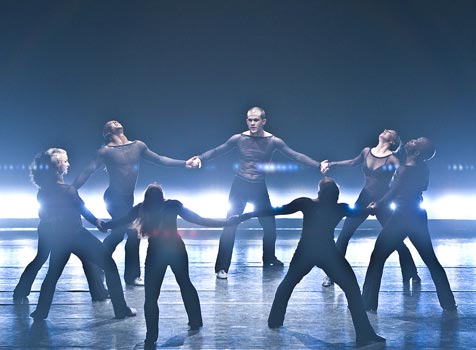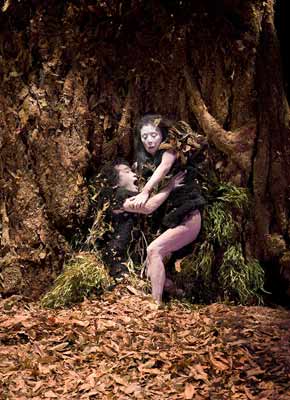Mourning, presented by Eiko and Koma
At Campbell Hall, Thursday, May 1. Parsons Dance. At the Lobero Theatre, Friday, May 2.

Last week, Santa Barbara got an unusual double dose of modern dance: Eiko and Koma through UCSB Arts & Lectures one night, and Parsons Dance at the Lobero the next. The two companies share some common ground: Japanese dancers and choreographers Eiko and Koma have been based in New York City since 1976, and David Parsons founded his company there in 1985. Both companies tour internationally and are known for their workshops and master classes as well as for their performances. Both companies show an interest in making their work accessible to a larger public, and both push the far reaches of the body’s potential as an expressive instrument. And yet, I spent Thursday night watching two half-naked, middle-aged people roll around in a pile of leaf litter and Friday night watching nine fresh-faced athletes bounce around the stage in tight jeans. Experientially, the two performances could hardly have been more different.

Thursday night’s show at UCSB’s Campbell Hall was really a trio; Eiko and Koma performed Mourning as a dialogue with Margaret Leng Tan, the avant-garde pianist and protege of John Cage. Tan’s performance in and of itself was spellbinding; with every decisive chord she struck, she jerked her head, darting and pecking. To create some of the most gut-wrenching strains of Cage’s In the Name of the Holocaust, Tan padded softly around the Steinway on bare feet, leaning inside the lid to pluck at its strings.
On the stage beside her, amber lights rose slowly on two figures with wild hair, their torsos painted white, their lower bodies covered in black fur. Like ancient tree spirits they emerged slowly from a wild backdrop of tangled roots, shuffling and hobbling through a bed of dry leaves, emitting puffs of dust. Then, without warning, Koma stabbed Eiko through the heart with the shaft of an arrow, and what had seemed human became decidedly animal. Their black fur costumes pulled up to their shoulders, the duo flopped around like a pair of injured seals. They moaned, they grunted, and they shuddered. Armless, and as if in deep distress, Eiko repeatedly rose on her knees and flopped on top of Koma’s prone body. Eventually, they retreated into the undergrowth from which they had come, limbs twisted. Life, it seemed, was suffering.
In this wordless, plotless drama, unfolding in slow motion and often in silence, there was space to drop into a state of reflection so deep it bordered on the hypnotic. Memories and images came to me from beyond the realm of language. I left the theater limp with fatigue, unable to say what I had seen.
Twenty-four hours later, the curtain rose on Parsons Dance: eight well-muscled bodies clad in black velvet and mesh. The music-a recording of an original score by Tony Powell-erupted, and so did they, leaping and cutting through space in tight formations, tossing their legs into high attitudes, then marching in sync with their arms pumping like pistons. David Parsons’s dancers are half the age of Eiko and Koma, and his work is designed for tight, springy bodies and flashy technique. Along with the youth and the choreography comes a quality of self-consciousness-Here I am! Look at me!-and an almost violent physicality. These dancers were easiest to watch, and seemed most at ease, in “Kind of Blue,” a quartet set to the music of Miles Davis and incorporating passages of improvisation, where the uncomfortable quality of striving finally gave way to the easy satisfaction of being in the moment.

Unsurprisingly, the crowd loved Parsons’s gimmicks, including “Hand Dance,” in which only the forearms and hands were illuminated by a shaft of light, and “Caught,” in which a carefully timed strobe light captured a single male dancer midair as he jumped, and plunged all else into darkness, so that he appeared to levitate and fly.
Post Parsons, I left the theater relatively unaffected, ready for the evening’s next activity. There’s a place in the arts for both experiences: for work that challenges and confronts on the deepest levels, and for work that exists to entertain. Although some of the best performances do both, if I have to choose, I’ll take a rare challenge over the well-done entertainment.



